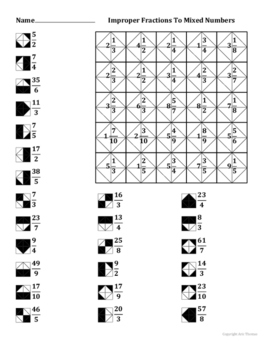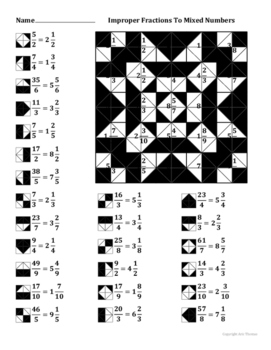Converting Improper Fractions To Mixed Numbers Color Worksheet
Aric Thomas
2.5k Followers
Resource Type
Standards
CCSS4.NF.A.1
CCSS5.NF.A.1
Formats Included
- PDF
Pages
2 pages
Aric Thomas
2.5k Followers
What educators are saying
We use these as extra credit for the kids who have finished early and most voluntarily choose to do. Love the format and provides great practice for our math routines.
Description
25 unique and thought out questions on converting improper fractions to mixed numbers. Each question corresponds to a matching answer that gets colored in to form a symmetrical design. Not only does this make it fun and rewarding for students but it also makes it easy for students and teachers to know if the worksheet has been completed correctly. Great for classwork, homework, additional practice, extra credit, and subs. The designs can also be cut out and quilted together to make a great art piece. The pdf file contains the worksheet and a key. Please download the preview file to see exactly what you will get. Thank you.
Total Pages
2 pages
Answer Key
Included
Teaching Duration
N/A
Report this resource to TPT
Reported resources will be reviewed by our team. Report this resource to let us know if this resource violates TPT’s content guidelines.
Standards
to see state-specific standards (only available in the US).
CCSS4.NF.A.1
Explain why a fraction 𝘢/𝘣 is equivalent to a fraction (𝘯 × 𝘢)/(𝘯 × 𝘣) by using visual fraction models, with attention to how the number and size of the parts differ even though the two fractions themselves are the same size. Use this principle to recognize and generate equivalent fractions.
CCSS5.NF.A.1
Add and subtract fractions with unlike denominators (including mixed numbers) by replacing given fractions with equivalent fractions in such a way as to produce an equivalent sum or difference of fractions with like denominators. For example, 2/3 + 5/4 = 8/12 + 15/12 = 23/12. (In general, 𝘢/𝘣 + 𝘤/𝘥 = (𝘢𝘥 + 𝘣𝘤)/𝘣𝘥.)



